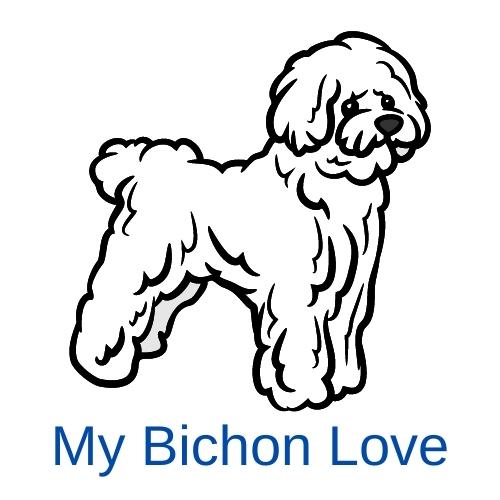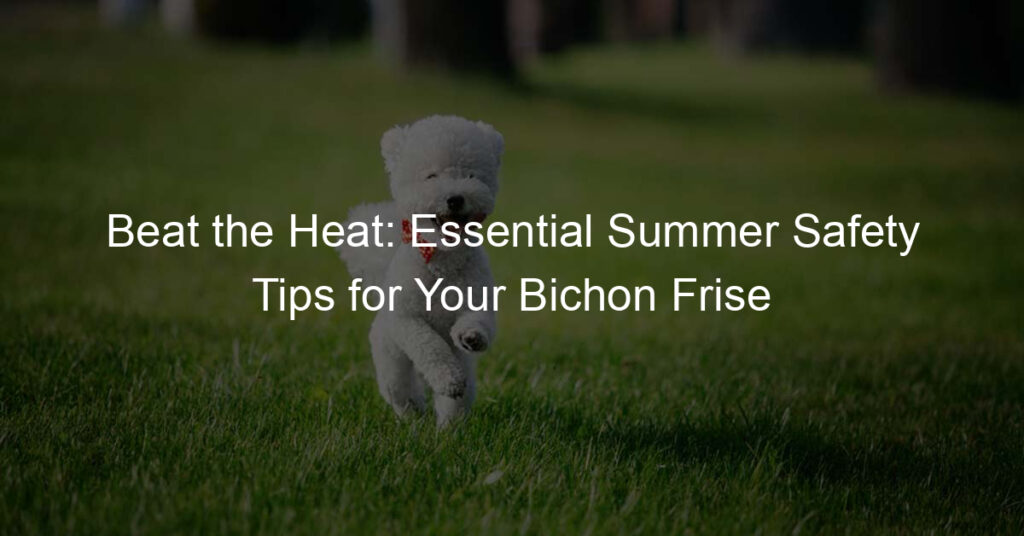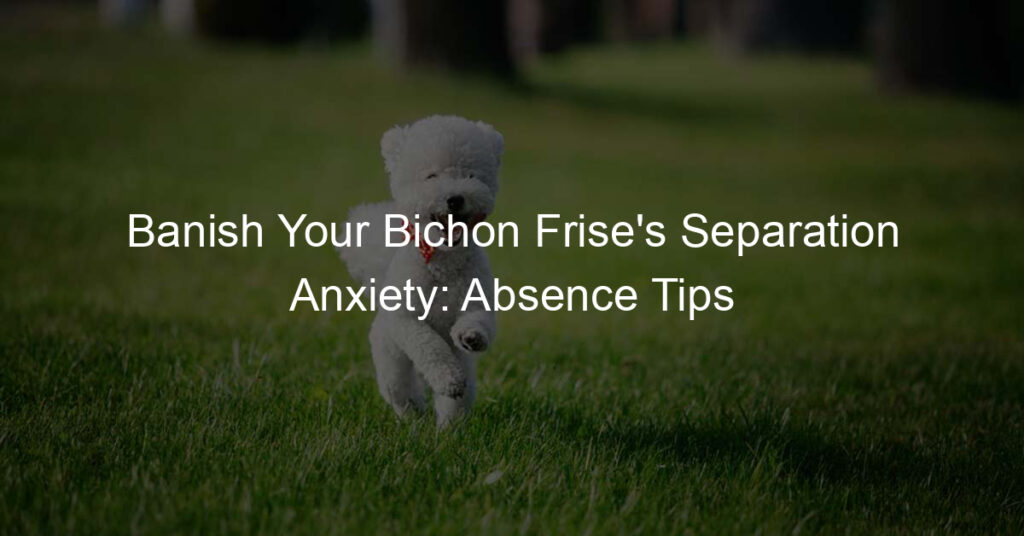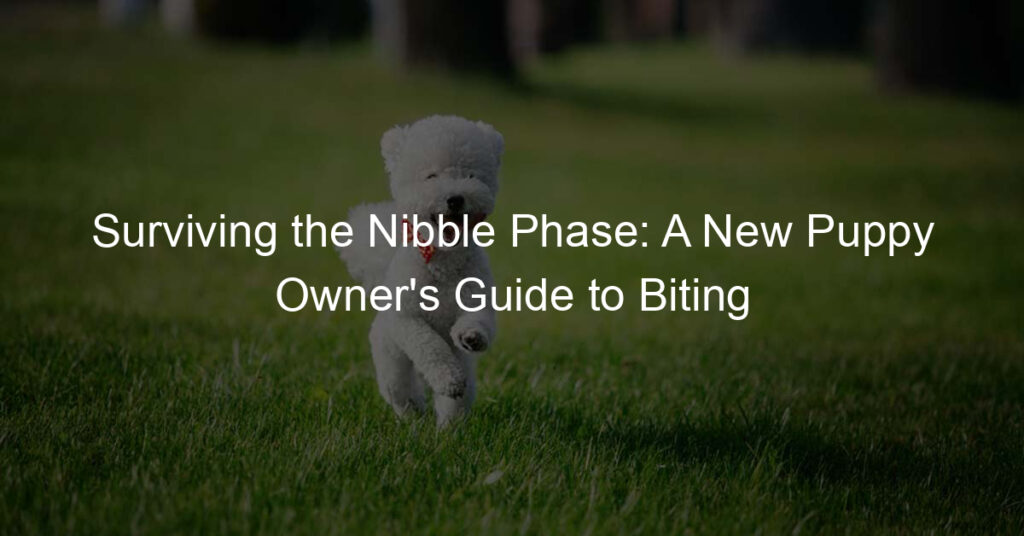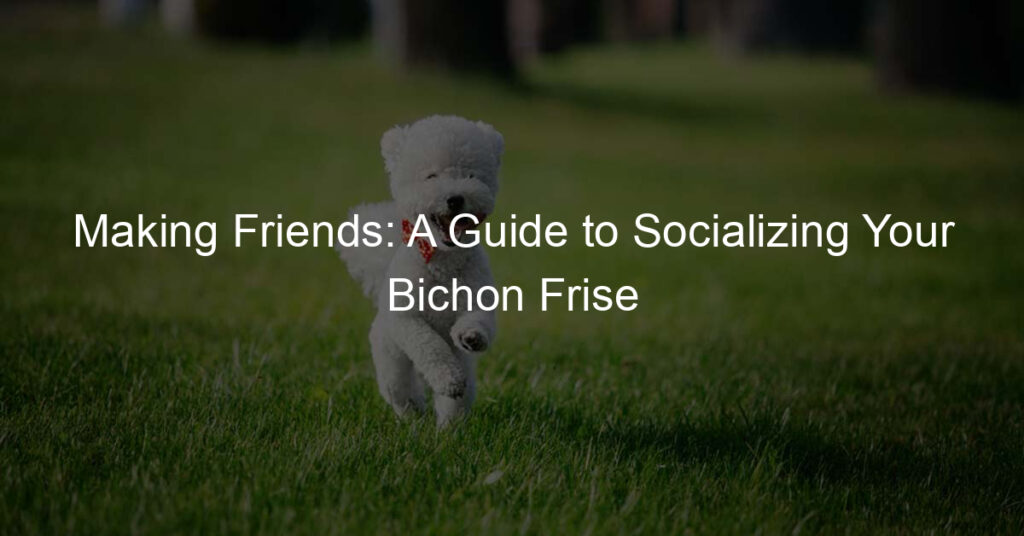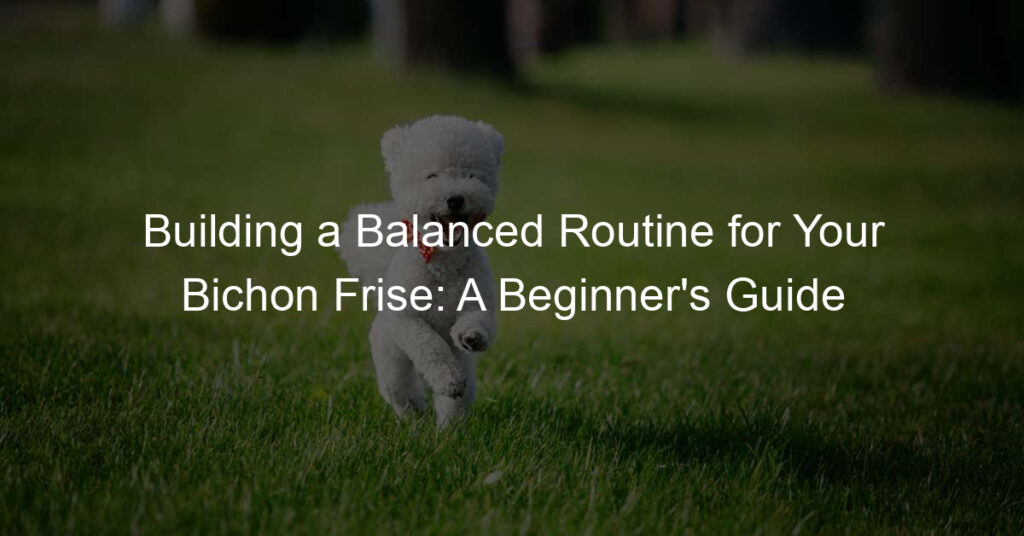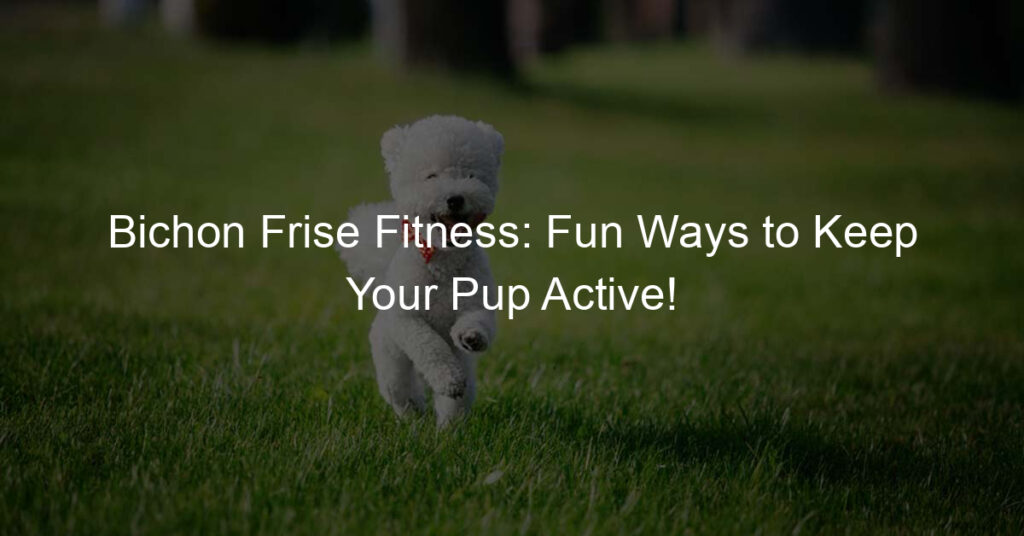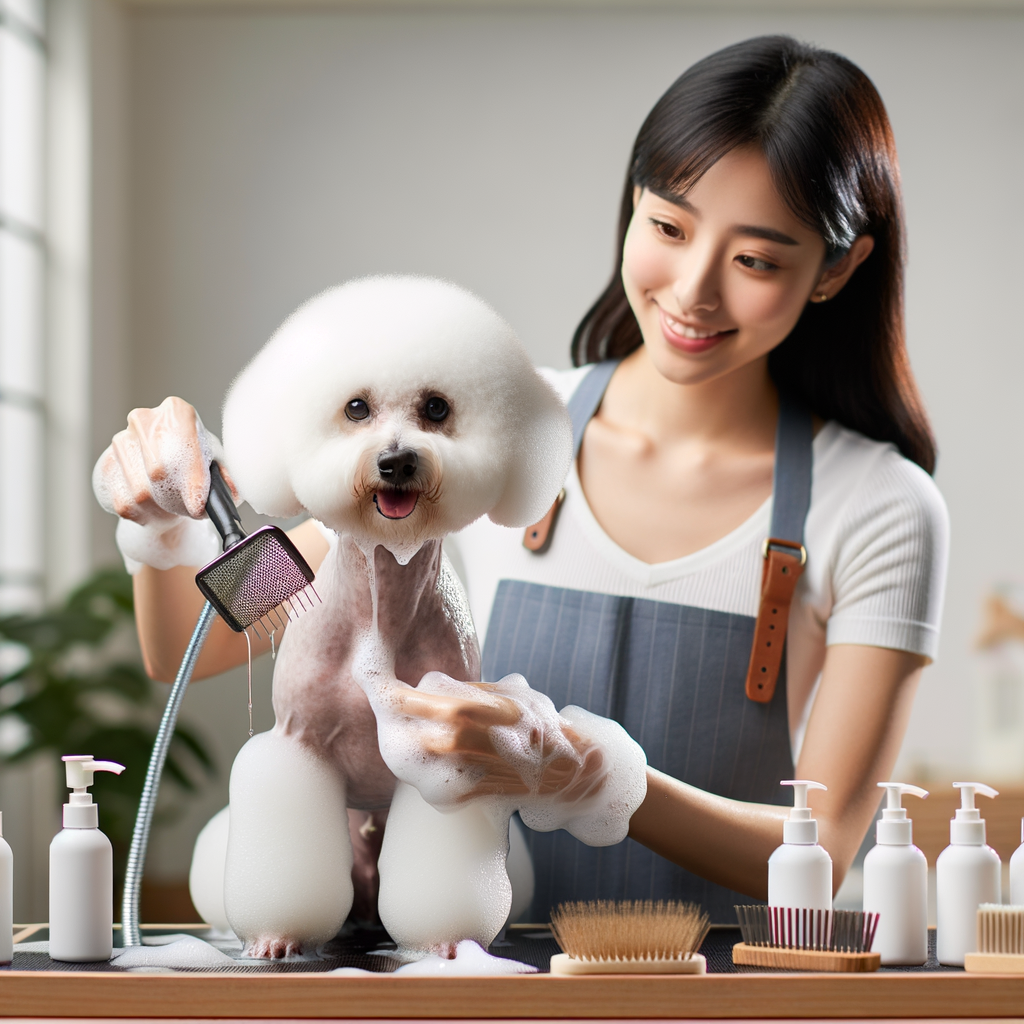
Introduction to Bichon Frise Grooming
When it comes to keeping your Bichon Frise looking its best, grooming is a crucial aspect. This guide will introduce you to the importance of grooming, the unique characteristics of the Bichon Frise coat, and the key tools you’ll need for proper grooming.
- Importance of grooming for Bichon Frise
Grooming is not just about maintaining your Bichon Frise’s appearance. It’s also about their health and comfort. Regular grooming helps to prevent skin conditions, matting, and discomfort. It also gives you a chance to check for any abnormalities, like lumps or skin changes, that might indicate a health issue. Plus, grooming sessions can be a great bonding time for you and your furry friend!
- Understanding the Bichon Frise coat
The Bichon Frise has a unique double coat. The undercoat is soft and dense, while the outer coat is curly and coarse. This coat type requires regular grooming to prevent matting and to keep it looking fluffy and white. Remember, a well-groomed Bichon Frise is a happy Bichon Frise!
- Key grooming tools for Bichon Frise
When grooming your Bichon Frise, there are a few key tools you’ll need. A slicker brush is essential for removing loose hair and preventing mats. A comb with both wide and narrow teeth can help to smooth the coat and remove any tangles. Nail clippers are needed to keep your Bichon’s nails at a comfortable length. Lastly, a good quality dog shampoo and conditioner will keep their coat clean and soft.
By understanding the importance of grooming, the unique characteristics of the Bichon Frise coat, and the key tools needed, you’ll be well on your way to keeping your Bichon Frise looking and feeling their best.
Bichon Frise Bathing Guide
Keeping your Bichon Frise clean is an essential part of their care. A clean Bichon Frise is a happy and healthy one. Let’s dive into how you can prepare for bath time to make it a pleasant experience for both you and your furry friend.
Preparing for Bath Time
Preparation is key when it comes to bathing your Bichon Frise. Here are some steps to help you get ready:
- Choosing the right shampoo for Bichon Frise: Not all shampoos are created equal, especially when it comes to your Bichon Frise. Their skin and coat require specific care. Look for a shampoo that is specially formulated for dogs, preferably one that is hypoallergenic and free from harsh chemicals. A good shampoo will clean your Bichon Frise’s coat without stripping it of its natural oils.
- Setting up a comfortable bathing area: Your Bichon Frise should feel safe and comfortable during bath time. Choose a quiet, warm place where your dog can relax. If you’re using a bathtub, place a non-slip mat on the bottom to prevent your dog from slipping. Have all your supplies (shampoo, towels, etc.) within reach before you start.
Remember, preparation is key to a successful and stress-free bath time. By choosing the right shampoo and setting up a comfortable bathing area, you can ensure that your Bichon Frise’s bath time is a positive experience.
During Bath Time
Now that you have prepared your Bichon Frise for bath time, let’s move on to the actual bathing process. This process involves three main steps:
- Wetting the Bichon Frise’s Coat
- Applying Shampoo and Massaging
- Rinsing Thoroughly
Wetting the Bichon Frise’s Coat
The first step in bathing your Bichon Frise is to wet its coat thoroughly. This breed has a thick, curly coat that can be difficult to penetrate, so it’s important to ensure that the coat is completely wet before applying shampoo. Use warm water, as it is more comfortable for your pet and helps to open up the hair follicles, allowing the shampoo to work more effectively.
Applying Shampoo and Massaging
Once the coat is wet, it’s time to apply the shampoo. Use a shampoo specifically designed for dogs, as human shampoos can be too harsh for their skin. Apply the shampoo to the coat and gently massage it in, making sure to reach all areas of the body. This not only helps to clean the coat, but also provides a relaxing massage for your pet.
Rinsing Thoroughly
The final step in the bathing process is to rinse the coat thoroughly. This is crucial as any leftover shampoo can cause skin irritation. Rinse until the water runs clear, ensuring that all the shampoo has been removed. Be careful not to get water in your pet’s eyes or ears, as this can cause discomfort or even lead to infections.
Remember, bathing should be a positive experience for your Bichon Frise. Always use gentle, reassuring tones and reward your pet with treats or praise after the bath. This will help to make future baths a more enjoyable experience for both of you.
After Bath Time
Once you’ve successfully bathed your Bichon Frise, it’s time to move on to the next steps. These are crucial for maintaining your pet’s cleanliness and overall health. Let’s take a look at what you need to do.
- Drying your Bichon Frise
After the bath, it’s essential to dry your Bichon Frise thoroughly. Leaving your dog wet can lead to skin issues and discomfort. Start by gently squeezing out excess water from the coat. Then, use a soft, absorbent towel to pat your dog dry. Avoid rubbing as it can cause tangles and matting in the fur.
For a quicker and more efficient drying process, you can use a pet-friendly hairdryer. Remember to set it on a low heat setting to prevent skin burns. Always keep the dryer moving and avoid focusing on one spot for too long. It’s also a good idea to give your Bichon Frise a treat or two during this process to make it a positive experience.
- Brushing the coat
Once your Bichon Frise is dry, it’s time to brush the coat. Regular brushing is crucial for this breed as it helps prevent matting and keeps the fur looking fluffy and clean. Use a slicker brush designed for dogs with curly or wavy coats. Start from the head and work your way down to the tail, brushing in the direction of hair growth.
Remember to be gentle and take your time. If you encounter a tangle, don’t pull on it. Instead, hold the fur close to the skin with one hand and gently work out the tangle with the brush in your other hand. This method will help avoid causing your pet any discomfort.
By following these steps, you can ensure that your Bichon Frise stays clean and comfortable after bath time. Remember, grooming is not just about maintaining your pet’s appearance, but also about ensuring their health and happiness.
Keeping Bichon Frise Clean Between Baths
Keeping your Bichon Frise clean between baths is essential for maintaining their health and hygiene. Here are some effective methods:
- Regular brushing
Regular brushing is a key part of keeping your Bichon Frise clean. It helps to remove dirt, debris, and loose hair from their coat. Brushing also helps to distribute natural oils throughout their fur, keeping it healthy and shiny. Aim to brush your Bichon Frise at least once a day.
- Spot cleaning
Spot cleaning is another useful method for keeping your Bichon Frise clean between baths. This involves cleaning only the dirty areas of your dog’s body, such as their paws or underbelly. You can use a damp cloth or a pet-safe cleaning solution for this. Remember to be gentle and avoid the eyes and ears.
- Using dog wipes
Dog wipes are a convenient and effective way to keep your Bichon Frise clean. They are especially useful for quick clean-ups after walks or before bed. Make sure to use wipes that are specifically designed for dogs, as human wipes can contain ingredients that are harmful to pets.
By incorporating these methods into your routine, you can keep your Bichon Frise looking and feeling their best between baths. Remember, a clean dog is a happy dog!
Bichon Frise Hygiene Beyond Bathing
While bathing is a key part of keeping your Bichon Frise clean, there are other aspects of hygiene that are equally important. One of these is dental care. Let’s delve into the specifics of maintaining your Bichon Frise’s dental health.
Dental Care
Just like humans, dogs also need regular dental care to maintain their overall health. This is especially true for Bichon Frises, who are prone to dental issues. Here are two key aspects of dental care for your Bichon Frise:
- Brushing your Bichon Frise’s teeth
Brushing your Bichon Frise’s teeth is not just about keeping their breath fresh. It’s also about preventing dental diseases. Plaque and tartar build-up can lead to serious health issues if not addressed. It’s recommended to brush your dog’s teeth at least two to three times a week. Use a dog-friendly toothpaste and a soft-bristled toothbrush. Start slowly and make the experience as positive as possible for your pet.
- Choosing the right dental chews
Dental chews are a great supplement to brushing. They help reduce plaque and tartar build-up and also keep your Bichon Frise’s breath fresh. However, not all dental chews are created equal. Look for those that are vet-recommended and specifically designed for small breeds like the Bichon Frise. Always supervise your dog while they’re enjoying a dental chew to prevent choking.
Remember, a healthy mouth leads to a healthy dog. Regular dental care is not just about maintaining your Bichon Frise’s beautiful smile, but also about ensuring their overall well-being.
Ear Care
When it comes to Bichon Frise hygiene, ear care is of utmost importance. Regular ear checks and cleaning can help prevent infections and maintain your pet’s overall health. Here are two crucial steps to follow:
- Checking for Ear Infections
Ear infections can be a common issue for Bichon Frises due to their fluffy ears. It’s essential to regularly check your dog’s ears for any signs of infection. Symptoms can include redness, swelling, a strong odor, or your pet frequently scratching its ears. If you notice any of these signs, it’s best to consult with a vet immediately.
- Cleaning Your Bichon Frise’s Ears
Cleaning your Bichon Frise’s ears is a simple process that can be done at home. Start by gently lifting the ear flap to expose the ear canal. Use a vet-approved ear cleaning solution and gently squirt it into the ear canal. Massage the base of the ear to help the solution break down any debris or wax. After a few minutes, allow your dog to shake its head, which helps bring the loosened debris out of the ear canal. Finally, use a cotton ball or gauze to gently wipe the outer part of the ear canal. Remember, never insert anything into your dog’s ear canal as it can cause damage.
Regular ear care is a key part of maintaining your Bichon Frise’s hygiene and health. By checking for infections and cleaning your dog’s ears regularly, you can help ensure your pet’s comfort and well-being.
Dog Bathing Basics: What Every Owner Should Know
As a dog owner, it’s important to understand the basics of bathing your furry friend. This includes knowing how often to bathe them, the right water temperature, and the importance of rinsing. Let’s dive into these essential dog bathing basics.
- Frequency of baths
How often should you bathe your dog? Well, it depends on their breed, lifestyle, and health. Generally, a healthy dog should be bathed once a month. However, dogs with oily coats like Bichons may require more frequent baths, perhaps once a week. On the other hand, dogs with water-resistant coats like Golden Retrievers should be bathed less frequently, perhaps once every two months. Always consult with your vet to determine the best bathing schedule for your dog.
- Water temperature
The right water temperature is crucial for a comfortable bath. The water should be warm, not hot. A good rule of thumb is to aim for a temperature that’s comfortable for a baby’s bath, around 37-38 degrees Celsius (98-100 degrees Fahrenheit). This temperature is not only comfortable for your dog but also helps to effectively remove dirt and oil from their skin and coat.
- Importance of rinsing
Rinsing is an essential step in the bathing process. It ensures that all the soap and shampoo are removed from your dog’s coat. Leftover soap can cause skin irritation and dryness. Make sure to rinse thoroughly, paying special attention to hard-to-reach areas like under the tail and behind the ears. Remember, a well-rinsed dog is a happy and healthy dog!
In conclusion, bathing your dog is more than just a chore. It’s an opportunity to check for any abnormalities like lumps, rashes, or parasites. It’s also a bonding time between you and your pet. So, make sure to make the most of it by following these dog bathing basics.
Maintaining Bichon Frise Cleanliness: Case Studies
Let’s delve into some real-life examples of Bichon Frise owners who have successfully tackled common cleanliness challenges. These case studies will provide practical insights and solutions that you can apply to your own pet care routine.
- Case Study 1: Overcoming Bath Time Fears
Meet Bella, a playful Bichon Frise who used to dread bath times. Bella’s owner, Sarah, noticed that Bella would become anxious and try to escape whenever she saw the bathtub. Sarah decided to take a step-by-step approach to help Bella overcome her bath time fears.
First, Sarah started by placing Bella in an empty bathtub and rewarding her with treats. Gradually, Sarah introduced a small amount of water, always ensuring Bella felt safe and comfortable. Over time, Bella began to associate bath time with positive experiences and rewards, helping her overcome her fear.
This case study shows the importance of patience and positive reinforcement in helping your Bichon Frise overcome bath time fears.
- Case Study 2: Dealing with Skin Allergies
Next, let’s look at Max, a Bichon Frise who suffered from skin allergies. Max’s owner, John, noticed that Max would frequently scratch and bite his skin, causing redness and discomfort.
John consulted a vet who recommended a hypoallergenic shampoo specifically designed for dogs with sensitive skin. John also started to regularly brush Max’s coat to remove any allergens. After a few weeks, Max’s skin condition improved significantly.
This case study highlights the importance of using the right grooming products and regular brushing in managing skin allergies in Bichon Frises.
Both these case studies illustrate that with patience, the right approach, and appropriate grooming products, you can maintain your Bichon Frise’s cleanliness and ensure they are comfortable and healthy.
Conclusion: Bichon Frise Care Tips for a Fresh Coat
As we wrap up this comprehensive guide on Bichon Frise grooming, let’s revisit some of the key points we’ve discussed. These tips will help you maintain a fresh and clean coat for your Bichon Frise, ensuring they stay happy and healthy.
- Recap of Bichon Frise bath routine: Bathing your Bichon Frise is a crucial part of their grooming routine. Remember to use a gentle, dog-friendly shampoo and conditioner, and bathe them every 3-4 weeks. Always ensure the water is lukewarm, not too hot or cold. Rinse thoroughly to avoid any leftover soap that can cause skin irritation. After the bath, towel dry your dog and use a hairdryer on a low setting to dry their coat completely.
- Importance of regular grooming: Regular grooming is not just about maintaining your Bichon Frise’s appearance; it’s also about their health. Brushing their coat daily will prevent matting and tangles, and it’s also a great opportunity to check for any skin issues or parasites. Regular grooming also includes cleaning their ears, trimming their nails, and brushing their teeth. This routine care will keep your Bichon Frise looking their best and feeling their healthiest.
- Final tips for keeping your Bichon Frise clean and happy: In addition to regular baths and grooming, remember to keep your Bichon Frise’s living area clean. This includes their bedding, toys, and food and water bowls. Regular exercise and a balanced diet also contribute to a healthy, shiny coat. Lastly, always pay attention to any changes in your Bichon Frise’s coat or skin. If you notice anything unusual, consult your vet immediately.
In conclusion, taking care of your Bichon Frise’s coat requires a bit of time and effort, but the results are well worth it. A clean, well-groomed Bichon Frise is a happy Bichon Frise. With these tips in mind, you’re well-equipped to keep your furry friend looking and feeling their best.
